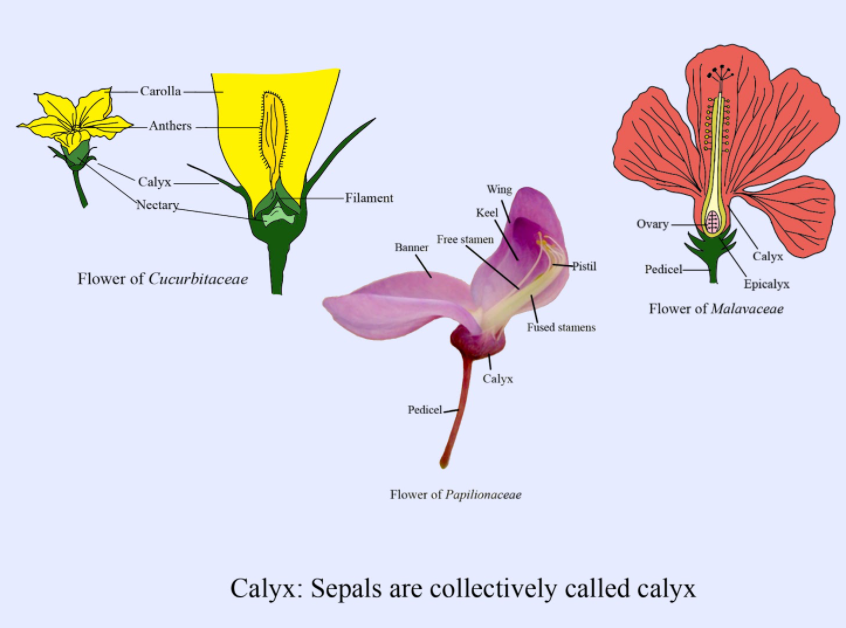
Character common between Malvaceae, Papilionaceae, and Cucurbitaceae
(a)Cohesion of sepals
(b)Cohesion of carpels
(c)Cohesion of petals
(d)None of the above
Answer
559.2k+ views
Hint: The popular character found in the three families is a part of the flower that is wholly united. Angiosperms belong to this component. They're usually green in color. Their vital purpose is to protect the budding flower.
Complete answer:
Sepals seem to be the non-essential floral components that do not engage in sexual reproduction and build the outermost whorl of green floral organs that cover the bud-like parts of the flower.
Family Malvaceae exhibits contorted or twisted aestivation which is characterized by the presence outside its neighbor of one margin of each petal or sepal and the other margin inside its neighbor, meaning that they alternately overlap each other.
The subfamily Papilionaceae is distinguished by vexillary aestivation, where the posterior petal is superimposed on one margin of the two lateral petals. The two anterior petals that are joined overlap the other margin of these two lateral petals.
Cucurbitaceae exhibit imbricate aestivation, in which irregularly the margin of petals overlaps each other.
Malvaceae and Cucurbitaceae have syncarpous multicarpellary and tricarpellary ovaries, respectively, but there is a monocarpellary ovary in the Papilionaceae subfamily. The three families listed thus demonstrate the cohesion of sepals.
So, the correct answer is, ‘Cohesion of sepals’.
Note: Cucurbitaceae (cucurbits or gourds) belong to the family of plants consisting of about 965 species in about 95 genera. The most important of the plants in this family for humans are:
Citrullus (watermelon), Cucumis (cucumber), and Cucurbita (squash, pumpkin, zucchini, and some gourds).
Of the three families of the order Leguminales, the family Papilionaceae is the largest. This includes a genus of around 375. Family members are spread in the temperate regions of both the northern and southern hemispheres.
Malvaceae, or mallows, is an approximate flowering plant family comprising 244 genera with 4225 species recognized. Well-known economically significant members include okra, cotton, cacao, and durian.

Complete answer:
Sepals seem to be the non-essential floral components that do not engage in sexual reproduction and build the outermost whorl of green floral organs that cover the bud-like parts of the flower.
Family Malvaceae exhibits contorted or twisted aestivation which is characterized by the presence outside its neighbor of one margin of each petal or sepal and the other margin inside its neighbor, meaning that they alternately overlap each other.
The subfamily Papilionaceae is distinguished by vexillary aestivation, where the posterior petal is superimposed on one margin of the two lateral petals. The two anterior petals that are joined overlap the other margin of these two lateral petals.
Cucurbitaceae exhibit imbricate aestivation, in which irregularly the margin of petals overlaps each other.
Malvaceae and Cucurbitaceae have syncarpous multicarpellary and tricarpellary ovaries, respectively, but there is a monocarpellary ovary in the Papilionaceae subfamily. The three families listed thus demonstrate the cohesion of sepals.
So, the correct answer is, ‘Cohesion of sepals’.
Note: Cucurbitaceae (cucurbits or gourds) belong to the family of plants consisting of about 965 species in about 95 genera. The most important of the plants in this family for humans are:
Citrullus (watermelon), Cucumis (cucumber), and Cucurbita (squash, pumpkin, zucchini, and some gourds).
Of the three families of the order Leguminales, the family Papilionaceae is the largest. This includes a genus of around 375. Family members are spread in the temperate regions of both the northern and southern hemispheres.
Malvaceae, or mallows, is an approximate flowering plant family comprising 244 genera with 4225 species recognized. Well-known economically significant members include okra, cotton, cacao, and durian.

Recently Updated Pages
Master Class 11 Economics: Engaging Questions & Answers for Success

Master Class 11 English: Engaging Questions & Answers for Success

Master Class 11 Social Science: Engaging Questions & Answers for Success

Master Class 11 Biology: Engaging Questions & Answers for Success

Class 11 Question and Answer - Your Ultimate Solutions Guide

Master Class 11 Business Studies: Engaging Questions & Answers for Success

Trending doubts
10 examples of friction in our daily life

One Metric ton is equal to kg A 10000 B 1000 C 100 class 11 physics CBSE

Difference Between Prokaryotic Cells and Eukaryotic Cells

1 Quintal is equal to a 110 kg b 10 kg c 100kg d 1000 class 11 physics CBSE

Explain zero factorial class 11 maths CBSE

What is a periderm How does periderm formation take class 11 biology CBSE




